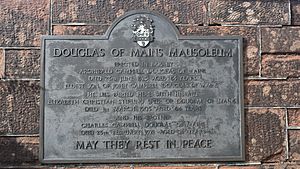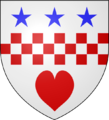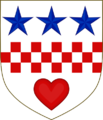Douglas of Mains facts for kids
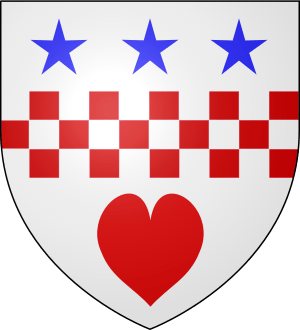
The Douglases of Mains were an important family in Scotland. They were a branch of the famous Clan Douglas, connected to the main Douglas family through Archibald I, Lord of Douglas. The first Laird (or landowner) of Mains got his land by marrying into the Galbraith family. This family had been given land in New Kilpatrick by Maldowen, the Earl of Lennox.
Over time, the Douglases of Mains became minor nobles in the Scottish court. One of the most well-known was Malcolm Douglas, the 8th Laird. He was executed for treason in Edinburgh because he was involved in a plot called the Raid of Ruthven. His second son, Robert Douglas, later became Viscount of Belhaven. The family often married into other important families in the Glasgow area and across Scotland. The title of Laird of Mains ended in the 20th century. The last part of their estate, including the family house, was sold to Dunbartonshire county. This land was then used to build a secondary school called Douglas Academy in Milngavie.
Contents
The Douglas Mains Family and Their Title
The Douglases of Mains were connected to the main Lords of Douglas family through Archibald I, Lord of Douglas. The title of Laird of Mains was created in 1373. This happened when Nicholas Douglas, whose father was the fourth Lord of Hermiston, married Janet Galbraith. Through her, he received the lands of Mains. However, it took until 1672 for the 11th Laird to officially register the family's coat of arms with the Lord Lyon King of Arms.
From the early 1700s, it became harder to track who held the title. This was because the Mains title became linked with another family, the Campbells of Blythswood. Both titles were held by the same larger family, but never by the same person at the same time. The title of Laird of Mains officially ended in 1928. This happened when the last heir, Archibald Vivian Campbell Douglas, was allowed to sell the estate. He later had two daughters. Archibald VC Douglas passed away at his home near Aberfoyle, Stirling in 1977.
Who Were the Lairds of Mains?
Here is a list of the people who held the title of Laird of Mains:
- Nicholas Douglas, 1st of Mains (1372-1392)
- James Douglas, 2nd of Mains (1392-1420)
- James Douglas, 3rd of Mains (1420-1490)
- William Douglas, 4th of Mains (1490-1491)
- John Douglas, 5th of Mains (1491-1513) (He died at the Battle of Flodden)
- Alexander Douglas, 6th of Mains (1513-??)
- Matthew Douglas, 7th of Mains (??-1571)
- Malcolm Douglas, 8th of Mains (1571-1584) (He was executed in Edinburgh)
- Alexander Douglas, 9th of Mains (1584-1618)
- Archibald Douglas, 10th of Mains (died before 1672)
- John Douglas of Ferguston, 11th of Mains (died 1701)
- James Douglas, 12th of Mains (1701-1743) (He changed his name from Campbell to Douglas)
- John Douglas, 13th of Mains (1743–1756)
- James Douglas, 14th of Mains (1756–1767)
- Colin Douglas, 15th of Mains (1767-1801)
- Robert Douglas (1801–1804)
- Colin Douglas, 16th of Mains (1804–1820)
- Archibald Douglas, 17th of Mains (1820–1838)
- Colin Douglas, 18th of Mains (1838–1847)
- John Campbell Douglas, 19th of Mains (1847–1857)
- Archibald Campbell Douglas (1857-1925)
- Brig-Gen Douglas Campbell Douglas, 20th of Mains (1925-1927)
- Lt-Col Archibald Vivian Campbell Douglas, 21st of Mains (1927–1928; died 1977)
The Douglas Mains Family Coat of Arms
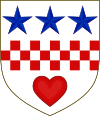
A coat of arms is a special design that represents a family or a group. The Douglas of Mains family officially registered their coat of arms in 1672. Here's what it looks like:
- It has a silver background.
- There's a horizontal band in the middle with a red checkerboard pattern.
- At the top, there are three blue stars. This is a bit different from other Douglas family arms.
- At the bottom, there's a red heart, shown in its natural color.
The top part of the arms, called the crest, shows an oak tree. The family's motto is Quae Serrata Secura, which means "What is locked is safe."
The design of these arms is based on the arms of the main Earl of Douglas family. When the Mains branch started, the Earl of Douglas arms had three stars and a heart without a crown. The red checkerboard band was added to the Mains arms to show their connection to the Lennox land. This land came to them through the Galbraith family. The original Lennox arms had a silver and blue checkerboard, but the Mains family changed the color to red, which was an old Lennox color.
The Mains Estate
The lands of Mains were given to Maurice Galbraith in the early 1200s by Maol Domhnaich, Earl of Lennox. The Galbraiths were a powerful family in the Stirling and Dumbarton areas. In 1296, "Arthur de Galbrait" was one of the important leaders who promised loyalty to King Edward I. One of their main homes was at Craigmaddie Castle, nearby.
The Galbraith family line ended in the late 1300s with three daughters who inherited the land. One of them, Janet, married Nicolas Douglas in September 1373. He then became the first Laird of Mains. The estate stayed mostly the same until the 1800s when the nearby Balvie lands were added. In 1884, the Mains estate covered about 1581 acres.
The Blythswood Connection
The Douglas of Mains family became closely linked with the Campbell family of Blythswood. This happened when John Campbell of Woodside married Mary Douglas, who was the daughter of the 11th Laird of Mains. They had two sons. Their second son, James Campbell, inherited Mains when his grandfather died. James then changed his name to Douglas. His older brother, Colin Campbell, became the second Laird of Blythswood.
Later, a rule was made that the Blythswood and Mains estates should not be owned by the same person. If a family member from Mains inherited the Blythswood title, they had to change their name to Campbell. This led to many name and title changes between the two families over the years.
Adding the Balvie Estate
The Balvie estate was next to Mains and had been owned by the Logan family for many years. In the 1600s, it was bought by Humphrey Colquhoun. Then, in 1700, Balvie was sold to Robert Campbell. Later, in 1767, it was bought by John Glassford, a very successful merchant. After his son Henry died in 1819, Balvie was bought by James Macnair. Finally, James Macnair sold it to John Campbell Douglas of Mains.
Once John Campbell Douglas bought Balvie, the two estates, Balvie and Mains, were joined together. The name Balvie was no longer used. The Balvie lands had originally been very large, but parts had been sold off over time. So, when the Mains family bought them, they were smaller.
When John Campbell Douglas took over Balvie, he made the house there the main home for the family. He changed its name to Mains and made it bigger. He married Helen Bogle and they had a son, Archibald Campbell Douglas.
Important Family Members
Matthew Douglas, 7th Laird of Mains
In 1571, Matthew Douglas of Mains, along with Thomas Crawford and John Cunningham of Drumquhassle, helped retake Dumbarton Castle. This was done on the orders of the Earl of Lennox. An official document was passed that year, protecting them from any legal problems for their actions in taking the castle.
Malcolm Douglas, 8th Laird of Mains
Malcolm Douglas of Mains was involved in a plot to influence the Scottish king. In August 1582, he and others, including the Earl of Gowrie, took King James VI prisoner at what is now Huntingtower Castle. This event is known as the Raid of Ruthven. The King later escaped.
Malcolm Douglas and others were brought to trial in 1584 for their part in the Raid of Ruthven. They were found guilty and sentenced to be executed in Edinburgh on the same day.
Over time, this story has been told in many ways, even by famous writers like Sir Walter Scott. Malcolm Douglas was described as a respected and brave gentleman. Some believed the witnesses against him might have been dishonest.
Margaret, Duchess of Douglas
Margaret, Duchess of Douglas, was the daughter of James Douglas of Mains (the 12th Laird). She became a Duchess by marrying Archibald Douglas, 1st Duke of Douglas. He was a distant relative from another branch of the Douglas family. Margaret and Archibald married later in life and did not have children. When Archibald died, his title of Duke of Douglas ended.
His estates became the subject of a famous legal battle called the Douglas Cause. This was between Archibald Steuart, the Duke's nephew, and the Duke of Hamilton. Margaret supported Archibald Steuart, who eventually won the estates after an appeal to the House of Lords. In her will, Margaret left money to buy lands that would be named Douglas-Support.
Captain Andrew Douglas
Captain Andrew Douglas of Mains was involved in the slave trade in the late 1600s and early 1700s. His daughter, Jean, married into the Kennedy family of Culzean Castle in 1705. A young West African boy named Scipio was taken by Andrew Douglas. After three years, Scipio was transferred to Jean after her marriage, possibly to work as a page. Scipio was educated and later gained his freedom in 1725. He continued to work for Jean and was given a house and land at Culzean.
Images for kids


